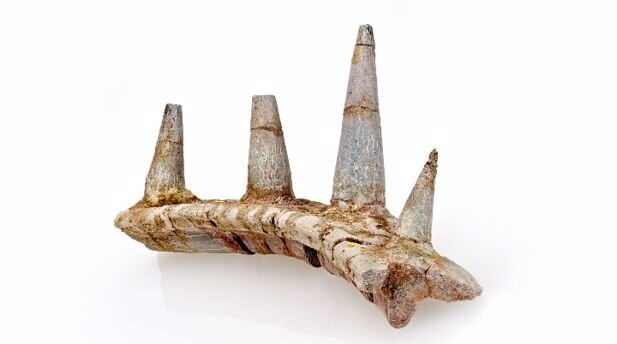If the ankylosaurids were a human family, then its newest member would be the rebellious punk-rock teenager.
Or perhaps the rebellious punk-rock grandfather?
On September 23rd, paleontologists lead by Dr. Susannah Maidment announced the discovery of a new species of ankylosaurid dinosaur. The new species – known as Spicomellus – represents a bizarre and potentially important member of the ankylosaurid family. The strangeness of Spicomellus stems from its osteoderms, the bony projections present on the body of ankylosaurids. Most ankylosaurids have flat, circular osteoderms that cover their body with a few sharp projections located on their shoulder. The osteoderms of Spicomellus are noticeably irregular, as their osteoderms are shaped like spikes. Besides making Spicomellus look like a medieval mace, the spiked osteoderms would have offered formidable protection. Additionally, the spikes are directly fused to the animals’ rib cage, another trait that is unique to Spicomellus amongst ankylosaurids.

The importance of Spicomellus stems from where it was discovered and when it lived. Spicomellus was discovered in Morocco and dates to the mid-Jurassic period, some 168 million years ago. Being discovered in Morocco is significant, as the fossil record for ankylosaurids in southern continents is poor. Having evolved in the northern hemisphere after Pangea split into two land masses – Laurasia in the north and Gondwana to the south – ankylosaurids are rare in the southern hemisphere. In total, three species from Antarctica and Australia have been named, while a fourth is known from fragmentary remains in South America. The discovery of Spicomellus in Africa may prove crucial in establishing how they evolved and dispersed in the south. Further analysis on Spicomellus may reveal if the Australian and Antarctic populations evolved in Gondwana over millions of years, or if they migrated from Laurasia instead.

The age of Spicomellus is important because the fossil record of ankylosaurids during the mid-Jurassic is also poor. The only ankylosaurid from this time is known as Sarcloestes, a species only known from a fragmentary jaw. A new species from this era will help clarify the evolution of the ankylosaurids as they transitioned from sheep-sized animals in the early Jurassic into the multi-tonne tanks of the late Cretaceous.
While I think the idea of a spiky ankylosaurid is awesome, I’m not quite sold yet. The only body part discovered was the spikes fused to the ribcage, which doesn’t exactly confirm that Spicomellus was an ankylosaurid. In fact, the closest relatives to the ankylosaurids – the stegosaurids – are well known in the Southern hemisphere, including from fossils in Morocco. After all, Stegosaurids are famous for their spikiness, so who’s to say that Spicomellus isn’t just another Moroccan Stegosaurid?

Having said this, a porcupine dinosaur is an awesome thought. Imagine traversing the Jurassic only to find a dinosaur that looks like a car straight out of Mad Max.
Pretty cool, right?
References
I do not take any credit for the images found in this article.
Spicomellus art courtesy of Joschua Knüppe, found here
Spicomellus spike courtesy of the Natural History Museum, found here
Spicomellus ribs courtesy of the Natural History Museum, found here
Maidment, Susannah C., et al. “Bizarre Dermal Armour Suggests the First African Ankylosaur.” Nature Ecology & Evolution, 2021, https://doi.org/10.1038/s41559-021-01553-6.

One reply on “Africa’s Punk-Rock, Porcupine Dinosaur”
[…] these organisms even more interesting. With the discovery of strange new members like Stegouros and the spiky Spicomellus, ankylosaurs have become one of the most diverse dinosaur families known to science. I mean, what […]
LikeLike